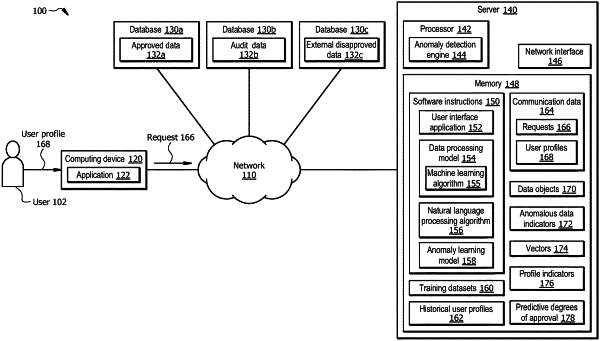| CPC H04L 41/16 (2013.01) [H04L 43/02 (2013.01); H04L 43/04 (2013.01); H04L 43/062 (2013.01); H04L 67/306 (2013.01)] | 20 Claims |

|
1. A system comprising:
a memory operable to store:
a plurality of user profiles each associated with a corresponding user request to be approved to interact with an entity; and
an anomaly learning model configured to predict an anomalous request for preventing an anomalous user interaction with the entity; and
a processor operably coupled to the memory, the processor configured to:
parse a first user profile from the plurality of user profiles to generate a first set of data objects associated with the first user profile;
compare the first set of the data objects to approved data retrieved from a first database to determine a first set of anomalous data indicators, wherein the approved data is associated with one or more user profiles that are currently approved by the entity, the first set of the anomalous data indicators each indicating a first anomalous relevance measure between the first set of the data objects and the approved data;
compare the first set of the data objects to audit data retrieved from a second database to determine a second set of anomalous data indicators, wherein the audit data is associated with one or more user profiles registered with one or more third party sources, the second set of the anomalous data indicators each indicating a second anomalous relevance measure between the first set of the data objects and the audit data;
generate a second set of data objects associated with the first user profile, the second set of the data objects comprising the first set of anomalous data indicators, the second set of anomalous data indicators, and the first set of the data objects;
process the second set of the data objects through the anomaly learning model to determine a predictive degree of approval associated with the first user profile; and
determine to approve, flag, or disapprove the first user profile based on the predictive degree of approval.
|